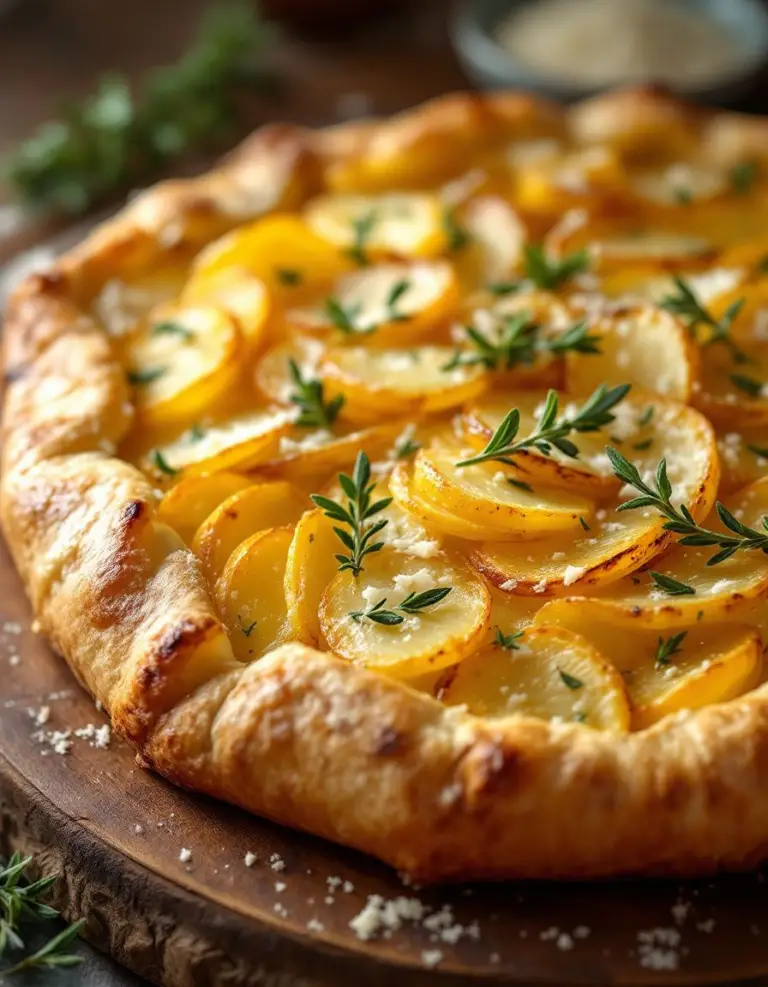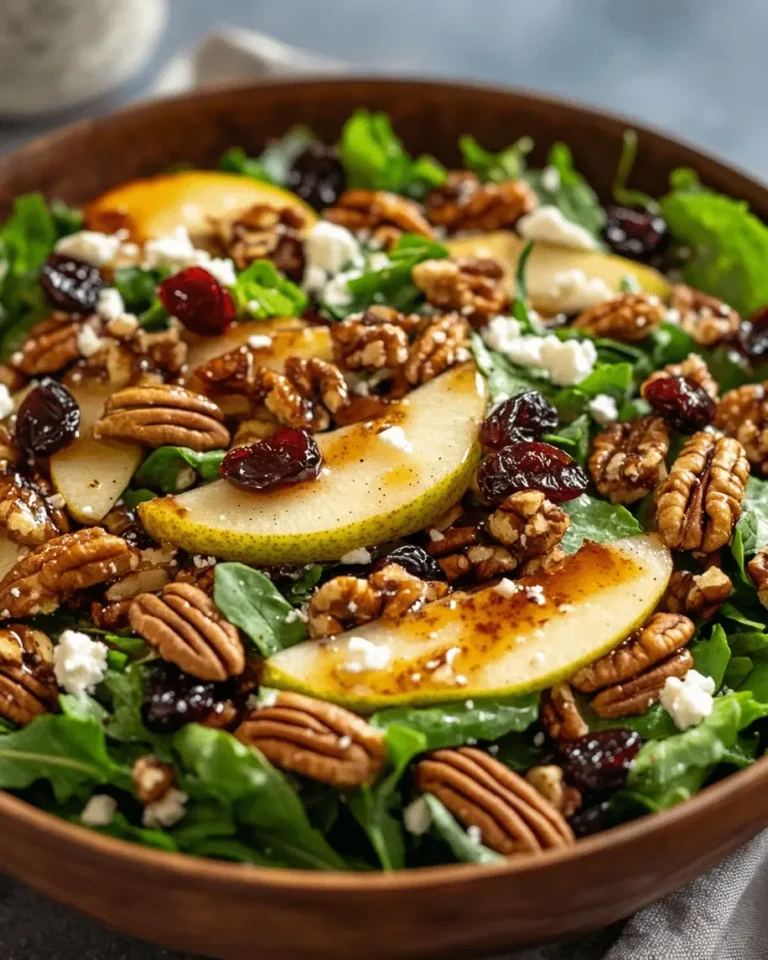Simple Spicy Chicken Noodle Soup
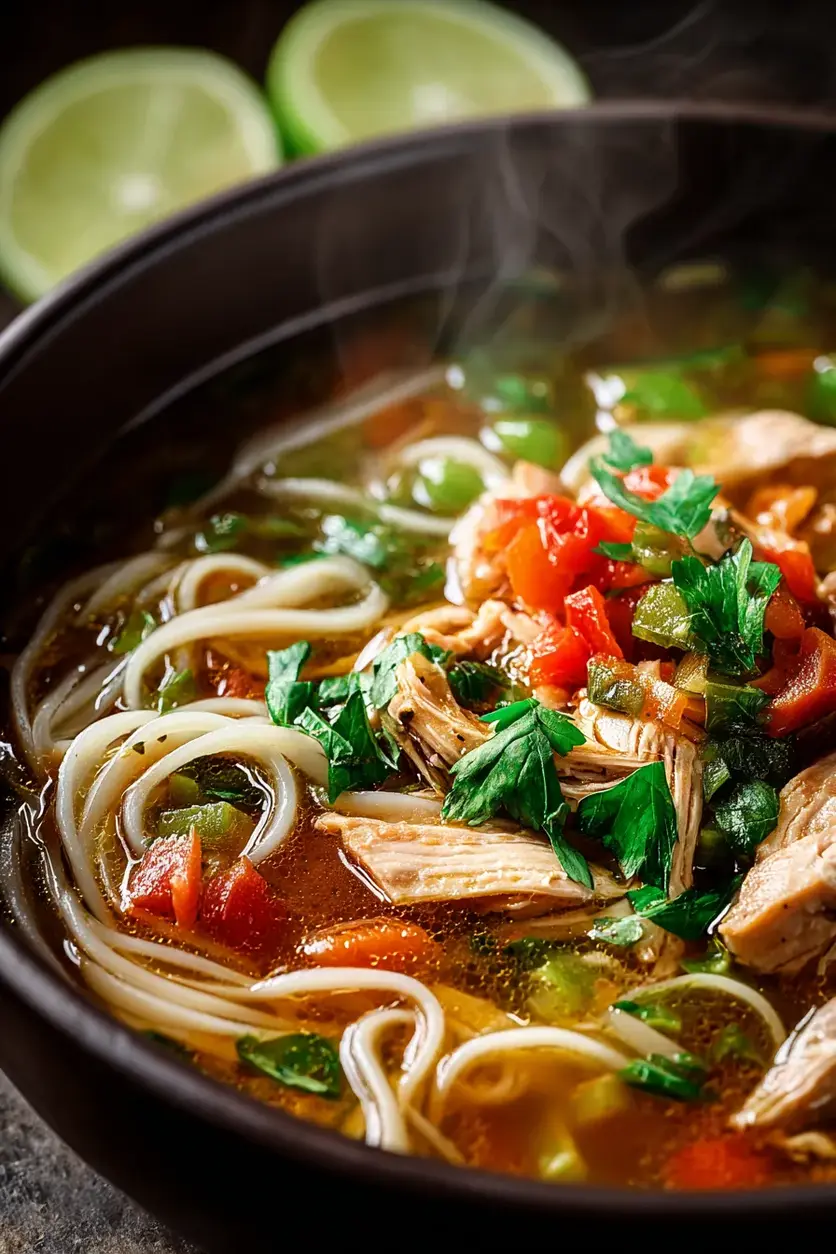
Table of Contents
- Spicy Chicken Noodle Soup: A Fiery Comfort in a Bowl
- Quick Recipe Highlights
- Recipe Overview
- Why You’ll Love This Recipe
- Historical Background and Cultural Significance
- Ingredient Deep Dive
- Common Mistakes to Avoid
- Essential Techniques
- Pro Tips for Perfect Spicy Chicken Noodle Soup
- Variations and Adaptations
- Serving and Presentation Guide
- Wine and Beverage Pairing
- Storage and Shelf Life
- Make Ahead Strategies
- Scaling Instructions
- Nutritional Deep Dive
- Dietary Adaptations
- Troubleshooting Guide
- Recipe Success Stories
- Frequently Asked Questions
- Additional Resources
Spicy Chicken Noodle Soup: A Fiery Comfort in a Bowl
Difficulty
Prep Time
Cook Time
Total Time
Servings
If you’re craving a comforting yet invigorating meal, dive into this spicy chicken noodle soup recipe that brings warmth and zest to your table. This spicy chicken noodle soup is not just a simple dish; it’s a flavorful explosion of tender chicken, al dente noodles, and a spicy broth that awakens your senses with every spoonful. Drawing from Asian-inspired traditions, it combines everyday ingredients into a hearty bowl that’s perfect for chilly evenings or when you need a quick, satisfying dinner. With its bold spices and fresh vegetables, spicy chicken noodle soup offers a delightful balance of heat and heartiness, making it an ideal choice for both novice cooks and seasoned food enthusiasts.
Beyond its mouthwatering taste, spicy chicken noodle soup stands out for its ease of preparation and nourishing qualities. In just 40 minutes, you can create a meal that serves four, proving that healthy eating doesn’t have to be complicated or time-consuming. The aromatic blend of garlic, onions, and chili flakes infuses the broth with a spicy kick that elevates the classic chicken noodle soup to new heights. Whether you’re battling a cold or simply seeking comfort food with a twist, this recipe delivers a satisfying experience that’s as fun to make as it is to eat.
Quick Recipe Highlights
- Flavor Profile: Spicy chicken noodle soup boasts a bold, fiery taste from the chili flakes that adds heat without overwhelming the subtle savory notes of chicken and broth. The garlic and onions provide a sweet undertone, while the vegetables like carrots and bell peppers introduce a fresh, earthy sweetness that balances the spice. Overall, it’s a harmonious blend of spicy, savory, and slightly sweet elements that make every bite memorable and crave-worthy.
- Texture: The tender, cubed chicken breasts offer a soft, juicy contrast to the firm, chewy egg noodles that hold their shape well in the broth. Vegetables such as sliced carrots and diced bell peppers add a satisfying crunch, enhancing the overall mouthfeel. This combination creates a multi-layered texture experience that’s both comforting and engaging, making spicy chicken noodle soup feel substantial and fulfilling.
- Aroma: The initial sauté of onions and garlic releases an inviting, pungent aroma that fills the kitchen, setting the stage for the dish. Chili flakes contribute a warm, peppery scent that builds as the soup simmers, mingling with the savory notes of chicken broth. This aromatic profile is deeply appealing, evoking feelings of coziness and anticipation with its spicy, herbal undertones.
- Visual Appeal: Served in a bowl, spicy chicken noodle soup presents a vibrant mix of colors from the orange carrots, green bell peppers, and golden noodles floating in a rich, reddish broth. The cubed chicken adds visual interest with its succulent pieces, making the dish look inviting and appetizing. This colorful presentation not only draws the eye but also hints at the fresh, wholesome ingredients within.
- Skill Level Needed: This recipe requires basic cooking skills like chopping and simmering, making it accessible for beginners while still offering a rewarding challenge for intermediates. With straightforward steps and common ingredients, spicy chicken noodle soup builds confidence in the kitchen without demanding advanced techniques. Mastering it can enhance your everyday cooking repertoire with minimal effort.
- Special Equipment: A large pot is essential for simmering the soup evenly, while a sharp knife aids in quickly chopping vegetables and chicken. You might also use a ladle for serving, but no fancy tools are required, keeping it simple for home cooks. This minimal equipment list makes spicy chicken noodle soup an easy recipe to prepare with what’s likely already in your kitchen.
Recipe Overview
- Difficulty Level: Rated as easy due to its straightforward steps and minimal techniques, spicy chicken noodle soup is perfect for those new to cooking as it involves basic sautéing and boiling. The recipe avoids complex methods, allowing even beginners to achieve great results with little risk of error. This level of simplicity ensures that anyone can enjoy preparing and customizing this dish without feeling overwhelmed.
- Category: As a main course soup, spicy chicken noodle soup fits into hearty meal categories, ideal for lunch or dinner rotations. It’s versatile for various dietary needs and can be a standalone dish or part of a larger spread. This category emphasizes its role as a comforting, filling option that satisfies hunger effectively.
- Cuisine: Inspired by Asian flavors, spicy chicken noodle soup draws from traditional broth-based soups like those in Chinese or Thai cuisine, incorporating elements like chili for heat. This influence brings a global twist to a familiar concept, making it adaptable while honoring its roots in quick, flavorful meals. The use of fresh ingredients reflects the emphasis on balance and health in these culinary traditions.
- Cost: The ingredients for spicy chicken noodle soup are budget-friendly, with staples like chicken breasts and vegetables costing around $10-15 for four servings. Fresh items like onions and garlic add minimal expense, while pantry staples like chili flakes keep costs low. This affordability makes it an accessible option for everyday cooking without sacrificing quality or taste.
- Season: Best enjoyed in colder seasons like winter or fall, spicy chicken noodle soup provides warmth and comfort during chilly weather. Its spicy elements can help clear sinuses, making it ideal for cold months, while lighter versions suit transitional seasons. This timing enhances its appeal as a seasonal staple for cozy gatherings.
- Occasion: Spicy chicken noodle soup is great for casual family dinners or quick weeknight meals due to its simplicity and satisfying nature. It’s also suitable for potlucks or sick-day remedies, offering both comfort and a touch of excitement. These occasions highlight its versatility for everyday enjoyment or impromptu entertaining.
Why You’ll Love This Recipe
The taste and texture appeal of spicy chicken noodle soup lie in its perfect harmony of spicy heat from chili flakes and the tender juiciness of chicken paired with chewy noodles. Each bowl delivers a symphony of flavors, from the savory broth to the crisp vegetables, creating a mouthwatering experience that’s both comforting and exhilarating. With every spoonful, you’ll appreciate the balance of spice and freshness, making it a go-to recipe for those seeking excitement in their meals. This dish’s accessibility ensures it’s not just delicious but also incredibly satisfying for all palates.
In terms of convenience and preparation benefits, spicy chicken noodle soup can be whipped up in just 40 minutes, fitting seamlessly into busy schedules. The simple steps minimize cleanup, and the use of common ingredients means less time shopping and more time enjoying. This recipe’s straightforward nature allows for easy scaling, whether you’re cooking for two or a crowd, enhancing its practicality for everyday life.
Nutritionally, spicy chicken noodle soup packs a punch with about 350 calories per serving, offering a good balance of protein from chicken and carbohydrates from noodles. It includes essential nutrients like vitamins from carrots and bell peppers, supporting overall health without overloading on fats. This makes it a smart choice for those monitoring their diet, providing a wholesome meal that’s both energizing and nourishing.
The social and entertaining value of spicy chicken noodle soup shines in its ability to bring people together around a warm, shared bowl. It’s perfect for family dinners or casual get-togethers, where the interactive preparation can foster conversation and fun. Serving it with variations allows for personalization, making it adaptable for different tastes and turning meals into memorable experiences.
Finally, spicy chicken noodle soup excels in cost-effectiveness and accessibility, using affordable, easy-to-find ingredients that keep expenses low. Its simple recipe means you can make it with pantry staples, reducing waste and promoting sustainable cooking. This combination of value and ease ensures it’s a practical option for anyone, regardless of budget or skill level, delivering high rewards with minimal investment.
Historical Background and Cultural Significance
Spicy chicken noodle soup traces its origins to traditional Asian soups, evolving from ancient broths in China and Southeast Asia that used noodles and proteins for sustenance. These early versions were developed as nourishing meals for laborers, incorporating local spices to add flavor and warmth. Over time, the recipe has been adopted globally, with influences from Western comfort foods blending into its core structure.
Culturally, spicy chicken noodle soup holds importance as a symbol of comfort and healing in many societies, especially in Asian households where it’s served during illnesses or cold weather. It represents hospitality and care, often prepared for family and guests to promote well-being. This dish’s role in daily life underscores its status as a staple that fosters community and emotional connections.
The evolution of spicy chicken noodle soup reflects changing tastes and ingredient availability, with modern versions incorporating chili flakes for added heat that wasn’t always present. As global trade introduced new spices, cooks began experimenting, leading to variations that suit contemporary palates. This adaptability has kept the recipe relevant, bridging traditional methods with innovative twists.
Regional variations of spicy chicken noodle soup highlight diverse influences, such as Thai versions with lemongrass for a citrusy kick or Mexican-inspired ones with cumin and cilantro. In the U.S., it’s often Americanized with more broth and less spice, while European adaptations might use different noodles. These differences showcase how the dish absorbs local flavors, making it a versatile canvas for culinary creativity.
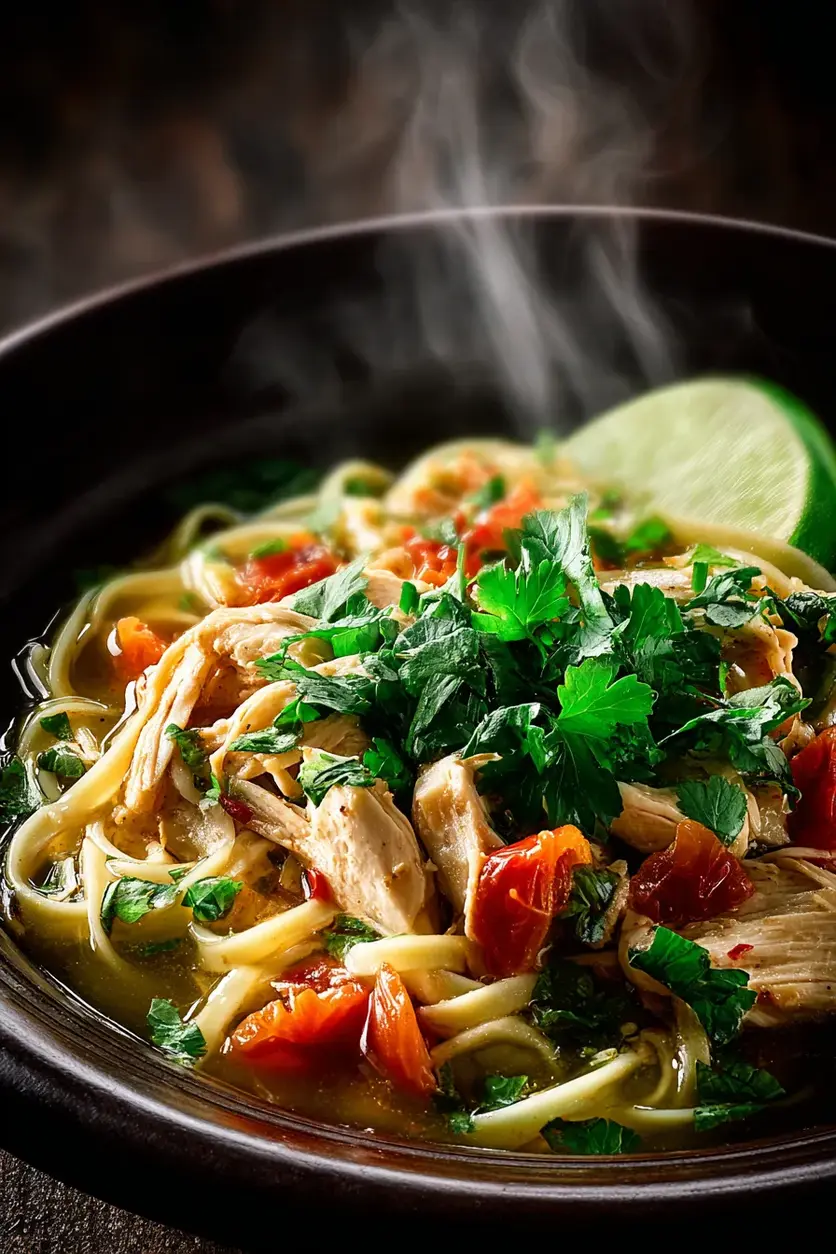
Ingredient Deep Dive
For boneless chicken breasts, their cultural significance stems from their prominence in global cuisines as a lean protein source, dating back to ancient farming practices in Asia and Europe. Nutritionally, they provide high-quality protein with about 25g per serving, supporting muscle health and satiety. When selecting, choose firm, pinkish breasts without any odor, and store them in the refrigerator for up to two days in airtight packaging. Substitution options include turkey for a similar texture or tofu for a plant-based alternative.
Chicken breasts offer benefits like low fat content at around 10g per serving, aiding in weight management, and they are rich in B vitamins for energy metabolism. Selection tips involve opting for organic or free-range for better quality and freshness. For storage, freeze them if not used immediately, thawing in the fridge to maintain safety. Common subs could be shrimp for a seafood twist, adjusting cook time to prevent overcooking.
Egg noodles have a history tied to Italian and Asian pasta traditions, serving as a staple in comfort foods worldwide. They provide complex carbohydrates at 45g per serving, offering sustained energy without spiking blood sugar. When picking egg noodles, look for those with a golden color and even texture; store in a cool, dry place for up to a year in sealed bags. You can substitute with rice noodles for a gluten-free option or zucchini noodles for a low-carb twist.
From a nutritional standpoint, egg noodles contribute to the soup’s balance with essential carbs and a bit of protein, while being low in sugar at just 5g per serving. Selection involves checking for freshness to avoid staleness, and proper storage prevents moisture absorption. Alternatives like soba noodles can add a nutty flavor, ensuring the recipe remains versatile for different dietary needs.
Common Mistakes to Avoid
- Overcooking the chicken, which can make it tough and dry, leading to a less enjoyable texture in your spicy chicken noodle soup; always monitor the heat and remove it from the pot once it’s browned to retain moisture. Adding too much chili early might intensify the spice unevenly, so incorporate it gradually for better flavor control. Remember, tasting as you go ensures the final dish meets your preferences.
- Using stale or low-quality broth, which dilutes the flavors and makes the soup bland; opt for fresh or homemade chicken broth to enhance the overall taste of spicy chicken noodle soup. Neglecting to chop vegetables uniformly can result in uneven cooking times, affecting the soup’s consistency. Proper prep work is key to a harmonious blend.
- Forgetting to season incrementally, as salt and pepper added all at once can overpower the natural spices in spicy chicken noodle soup; adjust seasonings after simmering for optimal balance. Boiling the noodles too long before adding them might make them mushy; add them towards the end for the right al dente texture. Timing is essential for success.
- Not sautéing onions and garlic properly, which can leave a raw, bitter taste in your spicy chicken noodle soup; cook them until softened to release their sweetness. Adding too many vegetables at once could crowd the pot, leading to undercooked pieces; stagger additions based on cook time. Attention to detail prevents common pitfalls.
- Using the wrong type of noodles, like thin pasta instead of egg noodles, which won’t absorb the broths flavors effectively in spicy chicken noodle soup; stick to varieties that hold up well. Ignoring the rest time after cooking allows flavors to meld, resulting in a more integrated taste. Patience enhances the final product.
- Skipping the chili flakes adjustment, potentially making the soup too mild or too hot for different tastes; customize based on preference for the best spicy chicken noodle soup. Failing to stir regularly can cause sticking at the bottom, burning the ingredients. Vigilance during cooking is crucial.
- Overloading the pot with ingredients, which might prevent the soup from simmering properly and affect its consistency in spicy chicken noodle soup; use a large enough vessel for even heat distribution. Not tasting for salt at the end can leave the dish unbalanced. Final adjustments make all the difference.
- Forgetting to let the soup cool slightly before serving, which could cause burns and diminish the enjoyment of spicy chicken noodle soup; allow a brief rest. Using cold broth straight from the fridge might lengthen cook time, delaying your meal. Preparation foresight is important.
- Substituting ingredients without considering cook times, like using frozen chicken, which could throw off the recipe for spicy chicken noodle soup; thaw in advance for accuracy. Adding bell peppers too early might make them overly soft. Planning substitutions carefully ensures success.
- Rushing the simmering process, which doesn’t allow flavors to develop fully in spicy chicken noodle soup; give it the full time for depth. Not cleaning equipment thoroughly can introduce off-flavors. Thoroughness is key to a great outcome.
Essential Techniques
Sautéing is crucial for building the soup’s base flavor in spicy chicken noodle soup, as it caramelizes onions and garlic to enhance depth and aroma. To master this, heat oil over medium and stir frequently to avoid burning, achieving a golden hue that signifies success. Common pitfalls include high heat causing scorching, so watch for visual cues like softening vegetables before proceeding.
Simmering ensures ingredients meld flavors without overcooking, vital for the tender chicken in spicy chicken noodle soup. Practice by maintaining a gentle bubble and adjusting heat as needed; aim to reduce the broth slightly for richness. Avoid boiling vigorously, which can toughen proteins, and look for the chicken to turn opaque as a sign of doneness.
Pro Tips for Perfect Spicy Chicken Noodle Soup
To achieve the ideal spice level, start with less chili flakes and add more after tasting; this prevents overwhelming heat and allows for personalization based on preferences. Adjusting early ensures the broth remains balanced, making your spicy chicken noodle soup enjoyable for everyone. Remember, spices intensify as the soup simmers, so build flavor gradually.
Use fresh, high-quality chicken for the best texture; marinating it briefly in garlic and herbs enhances juiciness and infuses more flavor. This step elevates the protein’s role in spicy chicken noodle soup, turning it into a standout element. Proper selection and prep make a noticeable difference in the final dish.
Don’t overcrowd the pot when adding vegetables; this ensures even cooking and retains their crunch, adding variety to spicy chicken noodle soup. Spacing out additions prevents steaming instead of sautéing, maintaining vibrant colors and textures. Monitoring the pot closely leads to better results.
Opt for al dente noodles by undercooking them slightly in the broth; this prevents them from becoming mushy in spicy chicken noodle soup. Timing is key, so test for doneness a minute early and let residual heat finish the job. This technique preserves the soup’s overall integrity.
Enhance aroma by blooming spices in hot oil first; this releases their essential oils and deepens the flavor profile of spicy chicken noodle soup. A quick stir achieves this without burning, making the kitchen smell inviting. Incorporating this step early sets the tone for a superior soup.
For leftovers, store the soup properly to maintain freshness; cool it quickly and refrigerate in airtight containers. This practice keeps spicy chicken noodle soup tasty for up to three days, allowing flavors to mature. Proper storage extends enjoyment without compromising quality.
Consider garnishing with fresh herbs like cilantro for added visual and taste appeal in spicy chicken noodle soup; it adds a bright, fresh note to the finished dish. This simple touch elevates presentation and provides a contrast to the warmth. Experimenting with toppings encourages creativity.
Finally, pair the soup with crusty bread to soak up the broth; this complements the spices and makes meals more satisfying. In spicy chicken noodle soup, this combination turns a simple recipe into a complete, hearty experience. Thoughtful pairings enhance the dining ritual.
Variations and Adaptations
Regional variations of spicy chicken noodle soup often incorporate local spices, such as using curry paste in Thai-inspired versions for a creamier broth. This adaptation adds layers of coconut and lemongrass, making it distinct while maintaining the spicy elements. Exploring these changes allows for a global twist on the original recipe, enhancing its versatility.
For seasonal adaptations, swap bell peppers for heartier vegetables like kale in winter to add more nutrients and robustness to spicy chicken noodle soup. This adjustment keeps the dish fresh and aligned with available produce, ensuring it’s both flavorful and seasonally appropriate. Such modifications help in creating a year-round favorite.
Dietary modifications for spicy chicken noodle soup include using vegetable broth and plant-based protein for a vegan version, replacing chicken with tofu or beans. This caters to various restrictions while preserving the soup’s comforting essence, making it inclusive for all eaters. Simple swaps ensure the recipe remains enjoyable and accessible.
Flavor variations can involve adding ginger or soy sauce to amp up the umami in spicy chicken noodle soup, creating a more complex taste profile. These enhancements allow for personalization based on mood or cuisine preferences, turning the basic recipe into something innovative. Experimenting with flavors keeps the dish exciting.
Texture modifications might mean using whole wheat noodles for a heartier feel in spicy chicken noodle soup, which adds fiber and a nuttier bite. This change can make the soup more filling, appealing to those seeking a textural contrast. Adjusting ingredients like this maintains the dish’s appeal across different preferences.
Presentation alternatives for spicy chicken noodle soup include serving it in individual bowls with a swirl of yogurt for a creamy visual effect. This technique adds elegance, transforming the meal from everyday to impressive. Creative plating inspires enjoyment and makes the soup suitable for various occasions.
Serving and Presentation Guide
Plating techniques for spicy chicken noodle soup involve layering noodles at the bottom and pouring broth over the top for an appealing display. This method highlights the ingredients’ colors and textures, making the dish more inviting. Proper arrangement ensures each serving looks professional and appetizing.
Garnishing ideas include sprinkling fresh herbs or sliced green onions on spicy chicken noodle soup to add color and freshness. These additions provide a pop of flavor and visual interest, elevating the overall experience. Experimenting with garnishes keeps the presentation dynamic and personalized.
Traditional accompaniments for spicy chicken noodle soup often feature crusty bread or steamed rice to soak up the flavorful broth. These sides complement the spice and provide a satisfying contrast, enhancing the meal’s completeness. Pairing with classics roots the dish in comfort.
Modern serving suggestions might include presenting spicy chicken noodle soup in a deconstructed style, with components arranged separately for interactive dining. This approach adds fun and engagement, making it ideal for family meals. Innovative ideas keep the recipe feeling contemporary.
Temperature considerations ensure spicy chicken noodle soup is served piping hot to maximize its comforting qualities. Allow it to cool slightly for safe enjoyment, preventing burns while preserving flavors. Proper temperature control enhances the sensory experience.
Portion control tips for spicy chicken noodle soup involve measuring servings to about one cup per person, avoiding overeating. This practice helps with balanced meals and accommodates dietary needs. Mindful portioning promotes health and satisfaction.
Wine and Beverage Pairing
For wine pairings, a crisp white like Sauvignon Blanc complements the spices in spicy chicken noodle soup, cutting through the heat with its acidity. This choice balances the broth’s richness, enhancing the overall dining experience. Selecting wines with light bodies ensures they don’t overpower the dish.
Non-alcoholic alternatives, such as ginger tea, pair well with spicy chicken noodle soup by echoing its warming notes without adding alcohol. This option provides a refreshing contrast, making it suitable for all ages. Herbal infusions can elevate the meal’s enjoyment.
If applicable, coffee pairings might not fit spicy chicken noodle soup, but a robust black tea can mirror its boldness. This beverage adds a caffeinated kick, complementing the flavors effectively. Choosing the right drinks enhances the soup’s profile.
Temperature considerations for beverages involve serving wines chilled and teas hot to contrast the soup’s warmth. This balance prevents palate fatigue and heightens taste sensations. Proper serving temperatures optimize pairings.
Serving suggestions include presenting beverages alongside the soup in coordinated glassware for a polished look. This setup encourages mindful sipping, integrating drinks seamlessly into the meal. Thoughtful pairings make the experience memorable.
Storage and Shelf Life
Storage methods for spicy chicken noodle soup involve transferring it to airtight containers to preserve freshness and prevent contamination. This practice maintains the soup’s flavors and textures, making it easy to reheat later. Proper storage is key for safety.
Temperature requirements mean keeping spicy chicken noodle soup refrigerated at below 40°F to slow bacterial growth. Avoid leaving it at room temperature for long periods to ensure longevity. Cool storage extends its usability.
Container recommendations include using glass or BPA-free plastic for spicy chicken noodle soup, as these materials don’t absorb odors. Label containers with dates to track freshness, aiding in meal planning. The right containers protect quality.
Signs of spoilage in spicy chicken noodle soup include off smells, color changes, or sliminess, indicating it’s no longer safe. Discard immediately if these appear to avoid health risks. Vigilance is essential.
Reheating instructions suggest warming spicy chicken noodle soup on the stove over low heat to retain its texture. Stir occasionally and add a splash of broth if needed to prevent drying. Gentle reheating preserves the original appeal.
Freezing guidelines for spicy chicken noodle soup involve portioning it into freezer-safe bags, where it can last up to three months. Thaw in the fridge overnight for best results, maintaining flavor integrity. Freezing offers convenient meal prep.
Make Ahead Strategies
Prep timeline for spicy chicken noodle soup allows chopping vegetables and chicken a day in advance, saving time on cooking day. This organization streamlines the process, making it ideal for busy schedules. Planning ahead reduces stress.
Storage between steps means refrigerating prepped ingredients separately to keep them fresh until assembly. This method prevents sogginess and maintains quality, especially for vegetables. Proper storage ensures efficiency.
Quality impact assessment notes that making spicy chicken noodle soup ahead might slightly dull flavors, but a quick reheat refreshes it. Assess by tasting before serving to adjust seasonings. This strategy balances convenience and taste.
Assembly tips involve adding noodles just before serving to avoid over-softening in spicy chicken noodle soup. This keeps textures optimal, enhancing the final dish. Sequential assembly preserves integrity.
Reheating guidelines recommend gentle warming to restore the soup’s heat without boiling, preserving the spicy elements. Monitor closely for the best results. Effective reheating maintains appeal.
Fresh element additions like fresh herbs at the end boost flavor in spicy chicken noodle soup made ahead. This keeps the dish vibrant and enjoyable. Incorporating fresh touches elevates the experience.
Scaling Instructions
Halving the recipe for spicy chicken noodle soup involves reducing ingredients proportionally, such as using one chicken breast and two cups of broth. This adjustment makes it perfect for smaller households, ensuring balanced flavors. Monitor cooking time to avoid over-reduction.
Doubling or tripling requires a larger pot to accommodate the volume, preventing overflow and uneven cooking in spicy chicken noodle soup. Adjust seasonings slightly, as flavors can intensify with scaling. This keeps the dish consistent.
Equipment adjustments might mean using a bigger ladle or more bowls for scaled versions of spicy chicken noodle soup. Ensure your tools can handle the increased quantity for smooth preparation. Proper equipment maintains efficiency.
Timing modifications for spicy chicken noodle soup when scaling could extend cook time slightly for larger batches, so check periodically. This prevents undercooking and ensures everything is heated through. Adjusted timing is crucial.
Storage considerations involve using multiple containers for larger quantities of spicy chicken noodle soup to manage portions effectively. Label clearly to track freshness, making it easier for future meals. Thoughtful storage enhances usability.
Nutritional Deep Dive
The macro breakdown of spicy chicken noodle soup includes 350 calories per serving, with 45g of carbohydrates for energy and 25g of protein for muscle repair. Fats at 10g provide satiety, creating a balanced nutritional profile. This distribution supports a healthy diet.
Micronutrient analysis reveals vitamins from vegetables like carrots, offering beta-carotene for eye health, alongside minerals from chicken. Spicy chicken noodle soup delivers essential nutrients in an approachable form, promoting overall wellness. Tracking these elements aids in meal planning.
Health benefits include immune-boosting properties from the spicy elements, helping with inflammation reduction. The protein in spicy chicken noodle soup aids recovery, while veggies contribute to digestive health. Regular consumption can enhance well-being.
Dietary considerations make spicy chicken noodle soup suitable for general diets, but watch sugar at 5g per serving for those monitoring intake. It’s naturally low in some allergens, making it versatile. Adjustments ensure inclusivity.
Portion analysis shows one serving provides a complete meal, with balanced macros for energy needs. This helps in controlling calorie intake for spicy chicken noodle soup enjoyers. Mindful portions support health goals.
Weight management tips involve pairing spicy chicken noodle soup with exercise, as its protein content promotes fullness. Moderating portions aids in calorie control, making it a smart choice for weight plans. Strategic incorporation enhances results.
Dietary Adaptations
For a gluten-free version of spicy chicken noodle soup, swap egg noodles with rice or quinoa noodles to maintain the dish’s chewy texture. This change eliminates gluten concerns while, preserving the spicy flavor profile. Ensuring all ingredients are certified gluten-free keeps it safe.
Creating a dairy-free spicy chicken noodle soup is straightforward since the recipe inherently lacks dairy, making it naturally compliant. Focus on using plant-based broths if needed, and enhance with coconut milk for creaminess. This adaptation broadens its appeal for those with restrictions.
A vegan adaptation replaces chicken with tofu or chickpeas in spicy chicken noodle soup, providing plant-based protein without sacrificing heartiness. Use vegetable broth and adjust seasonings to keep the spice intact, ensuring a flavorful, ethical meal. These swaps make it inclusive.
For low-carb spicy chicken noodle soup, omit noodles or use zucchini spirals to reduce carb count to under 20g per serving. This maintains the soup’s essence while supporting ketogenic goals, with spices adding satisfaction. Careful modifications enhance compliance.
In a keto version, focus on fatty elements like adding coconut oil to spicy chicken noodle soup, keeping net carbs low at around 10g. Incorporate more chicken and veggies to balance fats and proteins. This adaptation fits high-fat diets perfectly.
Paleo spicy chicken noodle soup uses sweet potato noodles and ensures all ingredients are unprocessed, aligning with primal eating. Skip grains and dairy to preserve the recipe’s integrity, making it nutrient-dense. These changes support ancestral health principles.
For low-FODMAP, remove onions and garlic from spicy chicken noodle soup, using green onion tops instead for flavor. This minimizes triggers while retaining the soup’s warmth, aiding digestive sensitivity. Adjustments make it accessible for specific needs.
Other specific diets, like Mediterranean, can incorporate olive oil more prominently in spicy chicken noodle soup for heart-healthy benefits. Use herbs instead of heavy spices to align with the diet’s focus on fresh ingredients. Tailoring ensures versatility.
Troubleshooting Guide
For texture issues in spicy chicken noodle soup, such as mushy noodles, reduce cooking time or add them later in the process to achieve al dente results. This common problem can be fixed by stirring frequently and monitoring the pot, ensuring the soup retains its desired consistency for an enjoyable meal.
If flavor balance is off, like too much spice, add more broth or a squeeze of lemon to mellow it out in spicy chicken noodle soup. Mastering this involves tasting incrementally and adjusting seasonings, avoiding the pitfall of over-spicing early. Visual cues, such as the broth’s color, help gauge success.
Temperature problems, such as the soup cooling too quickly, can be solved by serving in preheated bowls and covering to retain heat. For spicy chicken noodle soup, reheat on low to preserve flavors, preventing the loss of that comforting warmth. Proper techniques ensure the dish stays appealing.
Equipment challenges, like an undersized pot leading to overflow, require switching to a larger one for even cooking, as seen in spicy chicken noodle soup preparations. Mastering usage means checking capacity beforehand, with pitfalls like sticking avoided by consistent stirring. Success is evident when the soup simmers smoothly.
For ingredient substitutions in spicy chicken noodle soup, if chicken is unavailable, use turkey but reduce cook time to keep it tender. This addresses variations while maintaining nutrition, with common pitfalls like flavor mismatches fixed by tasting as you go. The final product should look and taste cohesive.
Timing concerns, such as the soup taking longer to cook, can be resolved by ensuring ingredients are prepped and the heat is adequate, as in spicy chicken noodle soup. Adjusting for variables like altitude prevents issues, with visual cues like bubbling broth signaling readiness.
Recipe Success Stories
Community feedback on spicy chicken noodle soup often highlights its comforting qualities, with many users praising how it eased their winter blues. These stories inspire others to try the recipe, sharing tips on making it a family favorite. Positive experiences build a sense of community.
Variation successes include adding mushrooms for extra earthiness in spicy chicken noodle soup, as shared by enthusiastic cooks. This adaptation led to rave reviews, showing how simple changes can enhance the dish. Success stories encourage experimentation.
Adaptation stories feature turning spicy chicken noodle soup into a slow-cooker version for convenience, with users noting its deepened flavors. These narratives demonstrate the recipe’s flexibility, helping others adapt for their lifestyles. Shared insights foster creativity.
Reader suggestions often recommend pairing spicy chicken noodle soup with salads, adding a fresh element to meals. This input from the community elevates the dish, providing new ways to enjoy it. Suggestions like these keep the recipe evolving.
Photography tips for spicy chicken noodle soup involve using natural light to capture its vibrant colors, as advised by successful bloggers. This technique makes posts more engaging, encouraging readers to share their own versions. Visual tips enhance the overall appeal.
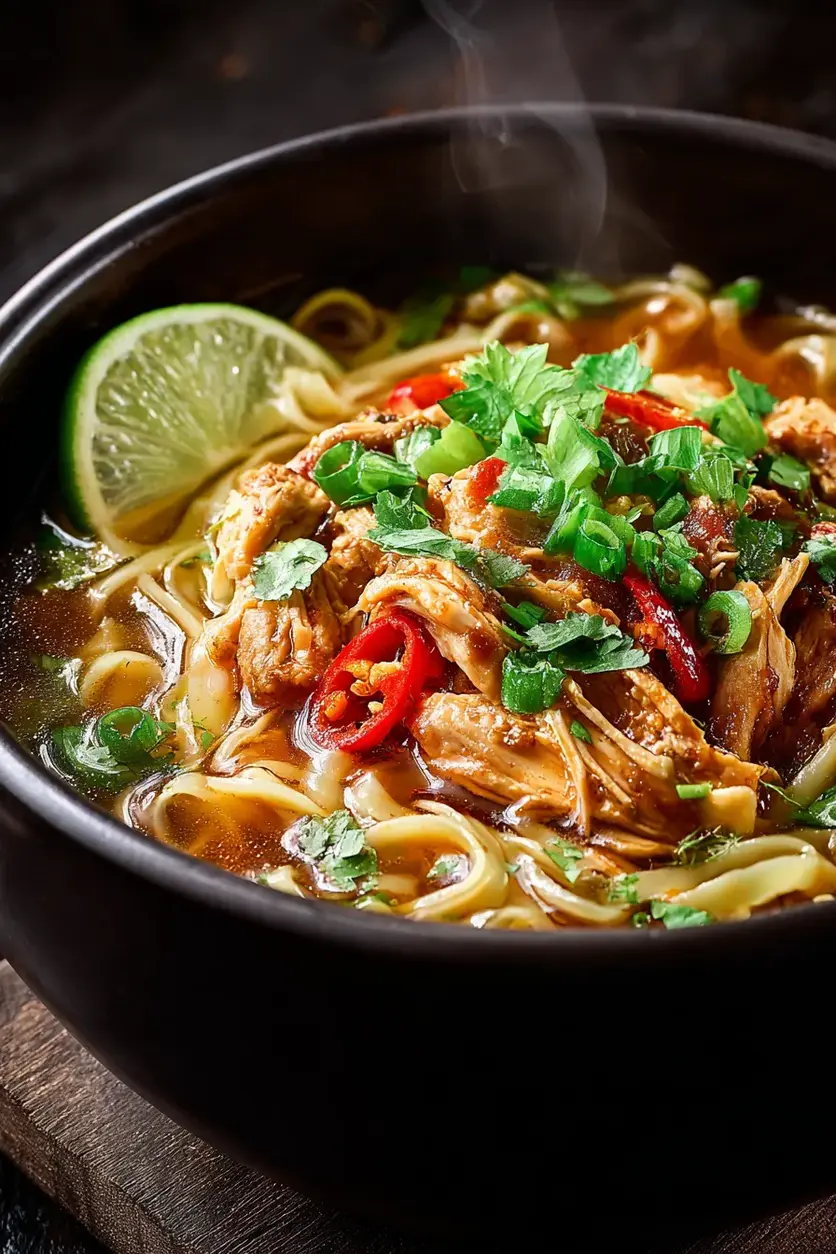
Frequently Asked Questions
How can I make Spicy Chicken Noodle Soup less spicy?
To reduce the heat in Spicy Chicken Noodle Soup, start by halving the amount of chili flakes or omitting them entirely and adding a pinch of paprika for mild flavor. You can also increase the chicken broth to dilute the spice, or incorporate more vegetables like carrots to balance the heat. This adjustment keeps the soup enjoyable while maintaining its comforting essence, allowing you to customize based on your tolerance.
What can I substitute for chicken in Spicy Chicken Noodle Soup?
For a chicken substitute in Spicy Chicken Noodle Soup, try tofu, shrimp, or even beans for a protein-packed alternative that absorbs the flavors well. Each option maintains the soup’s heartiness while catering to preferences, such as using plant-based choices for vegetarians. This swap ensures the recipe remains nutritious and versatile without compromising taste.
How long does it take to cook Spicy Chicken Noodle Soup?
Cooking Spicy Chicken Noodle Soup typically takes about 25 minutes for the main preparation after a 15-minute prep time, totaling 40 minutes. This timeline includes sautéing and simmering, making it a quick meal option. Factors like stove heat can vary it slightly, but following the steps ensures efficiency and great results.
What should I serve with Spicy Chicken Noodle Soup?
Pair Spicy Chicken Noodle Soup with crusty bread or a side salad for a complete meal that complements its flavors. These accompaniments add texture and balance the spice, enhancing the overall dining experience. Consider cultural twists like steamed rice for an Asian-inspired touch.
Can I make Spicy Chicken Noodle Soup in advance?
Yes, you can prepare Spicy Chicken Noodle Soup ahead by cooking and storing it in the fridge for up to three days. Reheat gently on the stove to preserve textures, making it ideal for meal prep. This strategy saves time while keeping the soup fresh and flavorful.
How do I store leftovers of Spicy Chicken Noodle Soup?
Store leftovers of Spicy Chicken Noodle Soup in airtight containers in the refrigerator for up to three days, or freeze for up to three months. Always cool the soup completely before storing to maintain quality and prevent bacterial growth. Proper methods ensure it tastes great when reheated.
What are some variations for Spicy Chicken Noodle Soup?
Variations for Spicy Chicken Noodle Soup include adding ginger for an extra kick or using different noodles like rice ones for a gluten-free option. These adaptations keep the dish exciting and tailored to your needs, enhancing its versatility. Experimenting can lead to personalized favorites.
Is Spicy Chicken Noodle Soup healthy?
Spicy Chicken Noodle Soup is healthy with around 350 calories per serving, providing protein, vitamins, and low sugar at 5g. It’s a balanced meal that supports immunity with its spices and veggies, but portion control is key for overall health. Incorporating it into a varied diet maximizes benefits.
Can I use frozen vegetables in Spicy Chicken Noodle Soup?
Yes, frozen vegetables can be used in Spicy Chicken Noodle Soup for convenience, but add them towards the end to avoid overcooking. This keeps the textures crisp and the soup flavorful, making it easier for quick meals. Adjust cooking time accordingly for the best results.
How do I reheat Spicy Chicken Noodle Soup?
To reheat Spicy Chicken Noodle Soup, use the stove on low heat with a splash of broth to restore moisture, taking about 5-10 minutes. This method prevents the noodles from becoming mushy and keeps the flavors intact. Microwaving is an option but stir frequently for even heating.
What makes Spicy Chicken Noodle Soup so comforting?
Spicy Chicken Noodle Soup’s comforting nature comes from its warm broth, tender chicken, and spicy kick that soothes on cold days. The combination of familiar ingredients creates a hug-in-a-bowl effect, making it a go-to for relaxation. Its quick prep adds to the appeal for everyday comfort.
How can I make Spicy Chicken Noodle Soup more filling?
To make Spicy Chicken Noodle Soup more filling, add extra protein like beans or increase the vegetables for volume and nutrients. This bulks up the servings without sacrificing flavor, helping with satiety. Balancing additions ensures it remains a hearty, satisfying meal.
Additional Resources
For related recipes, explore variations like vegetarian noodle soups that build on the Spicy Chicken Noodle Soup base, offering inspiration for dietary twists. These options provide endless ideas, helping you expand your cooking repertoire with similar techniques. Accessing such resources enhances your skills.
Technique guides on sautéing and simmering are essential for mastering Spicy Chicken Noodle Soup, with step-by-step videos explaining key methods. These tools break down the process, making it easier for beginners to achieve professional results. Detailed guides build confidence in the kitchen.
Ingredient information details the benefits of chili flakes


